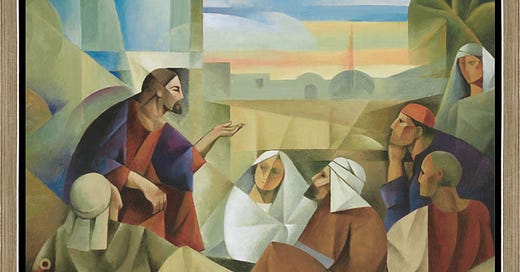Dear Friends,
A few years ago, after about six months together at my current parish, one of my church school children was determined to paint me as the worst daughter.
“She hasn’t seen her mom in ten years!” she would tell people about me.
No, no – I hadn’t *lived* with my mom in more than ten years. It had only been, oh, about 4 years since I had actually seen her or my dad, my grandmother, or my two little sister.
Combine these infrequent visits with the age gaps between my sisters and I and I will freely admit I don’t know very much about them. And that who knows how they talk about me when asked about their family. We are mysteries to each other, I think.
Physical or temporal distance are not the measure of unfamiliarity, but they certainly don’t help. Measurable distances can intermix with emotional proximity and physical proximity can some alongside emotional distance. And every family takes these pieces and forms their own tenuous and tender bonds out of the elements –
Anyway, can you tell that it’s Prodigal Son week?
There are lost sheep and lost coins, pearls of great price, and great wedding feasts. And then there’s that son who goes out, who squanders the good thing he has, and then returns – a bit piteous, perhaps, but to his father’s rejoicing.
And then there is the older brother. The one who does things right. But who also looks on this festival of joy upon his younger brother’s return with disdain and frustration.
It’s a classic and difficult parable and every parable asks us questions. Here they might include:
What did the prodigal son do while he was out in the world?
How did the older brother feel while his brother was gone – and what was their relationship like before that?
Why was the father so happy to see his seemingly irresponsible child?
Who else came to celebrate the son’s return – and why?
Where might this place really be? And who might these people be?
I’m not irresponsible, but as my story above my suggest, I might be understood at the prodigal son who has not yet – who might not ever – return. It is easy to judge the sullen older brother, to see ourselves as wanderers returning to a loving God, or even to think of ourselves as ready to embrace and forgive. We want to read parables, as one of my old Wiggles & Wonder posts puts it, like we’re the Disney princess in every story – held down but triumphant. At the end, we’ll inherit the throne, the shoe will fit, we’ll conquer the evil queen and restore the kingdom.
Sometimes we aren’t evidently in the parable. Or we’re one of the difficult characters.
Maybe, as I wrote about last week, we need more than one parable to understand our own place in the story, to understand the working of the what-if world of parables.
Maybe we’re prodigal sheep instead of sons, wandering from an ordinary shepherd to a good shepherd, celebrated like a lost coin. Let the shape be complicated. Let the story be rewritten.
That’s the thing about parables: None of this happened, but there is discovery in grappling with them, with trying to open that treasure box-gift-hand-me-down-lost-in-the-back-of-your-closet mystery of a story.
Resource Round-Up
What pieces are still missing in your Holy Week or Easter plans? I want to invite you back to this post from last year, which includes some notes on addressing anti-semitism in the Palm Sunday liturgy with children, and also includes a number of useful Holy Week & Easter links.
I also want to kick off our planning moves toward Holy Week with last year’s And Also With Your Episode with friend-of-the-newsletter Mtr. Emily Garcia on How to Talk about Jesus on the Cross with Kids. I’m glad somebody is asking those questions because with enough time hanging out in Godly Play, I can sometimes forget people have a hard time with that!
Sandra McCracken is one of my musical favorites and she’s certainly featured on some tracks I’ve shared here. Well, now she and her husband Tim Nicholson have written a new children’s book called “The Maker of the Mountain” out in a few months. I can tell you from everything I’ve seen that yeah, it’s gonna do masculine God language stuff, but that’s easy to change in the reading. What I love is that it is ultimately a story that takes the natural imagery of scripture as its foundation for helping readers know what God is like – and it does so through a bit of adventure: Little Brown Bear, the main character, wants to find the actual maker of the mountain. What a wonderful way to journey towards a greater intimacy with God.
Sarah Lund has been doing some incredible, important work around mental illness and other forms of neurodivergence in the church and I’m excited to share her conversation with Brian Allain about her new book “Blessed Minds: Breaking the Silence about Neurodiversity,” out yesterday (3/24/25) from Chalice Press. Sarah’s been making the rounds, also speaking at VTS through Lifelong Learning.
Personally, I’m the last person you’ll find following the Tribeca Film Festival. In fact, I probably can’t name more than one or two films that make the cut for the Oscars in any given year – so be surprised I’m ahead of the curve here, thanks to some excellent colleagues. Coming to theaters this week after its premiere at Tribeca last year is Audrey’s Children, a biopic about the Dr. Audrey Evans, a powerhouse pediatric cancer surgeon, co-founder of the Ronald McDonald House Charities, as well as co-founder of the St. James School in Philadelphia, a tuition-free Episcopal school serving an under resourced community. Evans believed that God put her on earth to help children and she did that work in countless ways throughout her life.
As author Ryan Burge notes, doing large scale research on very small populations is hard and the results can be sketchy at best – it’s just harder to get representative samples. That being said, he presents an interesting set of statistics about non-binary/gender-non-comforming gender identity and religious identification. And, furthermore, while Burge describes this group in its religious failures, essentially (of nb/gnc individuals “60% said that they were non-religious. 77% attended religious services less than once a year”), my colleague Mtr. Caitlyn Keith puts it a more hopeful way, especially given legacies of mistreatment and trauma, “that means 1 in 5 non-gender [conforming] folks are in our churches.” As she caps it off, “given *everything,* I think that’s amazing and cool and good.”
Now go back to thinking about thinking about parables! What questions do you want to ask? What do you want to wonder about? And how unflattered are you feeling by what the parables are telling you?
Peace,
Bird





